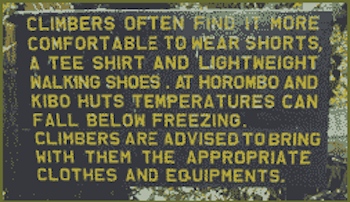 Essential Equipment for Kilimanjaro:
Essential Equipment for Kilimanjaro:
According to his book Life, Wanderings, and Labours in Eastern Africa, when Charles new attempted to climb Kilimanjaro in 1861 he took with him a party of thirteen porters, all of whom were completely naked. New and his crew became the first to reach Kilimanjaro’s snow-line, which is a rather creditable effort considering their lack of suitable apparel.

Assuming your goal is to reach more than just the snows of Kilimanjaro, however, you will need to make sure you (and indeed your porters) are appropriately attired for the extreme conditions. The fact that you will be paying porters to carry your rucksack does, to some degree, make packing simpler – allowing you to concentrate on warmth rather than weight.
However, packing for warmth does not mean packing lots of big jumpers. The secret to staying warm is to wear lots of layers. Not only does this actually make you warmer than if you just had one single, thick layer – the air trapped between the layers heats up and acts as insulation – but it also means you can peel off the layers one by one when you get too warm, and put them on again one by one when the temperatures drop.
A clothes list for Kilimanjaro:
Boots for Kilimanjaro Proper mountaineering boots are unnecessary for Kilimanjaro unless you’re taking an unusual route that demands them. If you’re not, a decent pair of trekking boots are fine for Kilimanjaro. The important thing about boots is comfort, with enough toe room, remembering that on the ascent up Kibo you might be wearing an extra pair or two of socks, and that on the descent the toes will be shoved into the front of the boots with every step. Remember these points when trying on trekking boots for Kilimanjaro in the shop. Make sure they are also sturdy, waterproof, durable and high enough to provide support for your ankles. Finally, ensure you break them in before you come to Tanzania, so that if they do give you blisters, you can recover before you set foot on Kilimanjaro.
Socks:
A couple of thick thermal pairs and some regular ones should be fine for trekking up Kilimanjaro; you may stink but you’ll be comfortable too, which is far more important. Some people walk in one thick and one thin pair of socks on Kilimanjaro, changing the thin pair regularly, rinsing them out in the evening and tying them to their pack to dry during the day.
Down Jacket:
Not necessary for Kilimanjaro if you have enough fleeces, but nevertheless wonderfully warm, light and compact – and usually expensive. Make sure it is large enough to go over all your clothes.
Fleeces:
Fleeces are light, pack down small, dry quickly and can be very, very warm. Take at least two fleeces for your Kilimanjaro expedition, one thick ‘polar’ one and one of medium thickness and warmth. Make sure that you can wear the thinner one over all of the T-shirts and shirts you’ll be taking, and that you can wear your thick one over all of these – you’ll need to wear both fleeces on the night-walk up Kibo.
Thermals:
The value of thermal underwear lies in the way it draws moisture (ie sweat) away from your body. A thermal vest and long johns are sufficient for Kilimanjaro.
Trousers:
Don’t take jeans, which are heavy and difficult to dry. Instead, take a couple of pairs of trekking trousers for Kilimanjaro, such as those made by Rohan, preferably one light and one heavy.
Sun-Hat:
One reader wrote in to say that, because he is a glasses wearer, a baseball cap or similar was much more useful than a regular sunhat as it kept the rain off his spectacles. This is a good idea but do make sure that you have something to cover the back of your neck too. Whatever you choose, headgear is essential as it can be hot and dazzling on the mountain.
Woolly/fleecy Hat:
It can also be very cold. Brightly-coloured bobble hats can be bought very cheaply in Arusha/Moshi or at the gate; or, better still, invest in one of those knitted balaclavas which you can usually find on sale in Moshi. They look a bit like a pizza oven but wearing a balaclava on Kilimanjaro will protect your face from the biting summit wind.
Gloves:
Preferably fleecy; many trekkers on Kilimanjaro wear a thin thermal under-glove too.
Rainwear:
While you are more likely to experience rain on Kilimanjaro during the walk in the forest, where it’s still warm, once you’ve got your clothes wet there will be little opportunity to dry them on the trek – and you will not want to attempt to climb freezing Kibo in wet clothes. A waterproof jacket is ideal for Kilimanjaro, preferably made from Gore-tex or similar breathable material, hopefully with a warm or fleecy lining too, and big enough to go over all your clothes so you can wear it for the night-walk on Kibo. Waterproof trousers on Kilimanjaro are perhaps a luxury rather than a necessity, but if you have a pair bring them with you. Alternatively, one reader suggests a cheap waterproof poncho ‘from a dollar store’ for the trek, preferably one that goes over the backpack as well as yourself.
Summer clothes:
T-shirts and shorts are the most comfortable things to wear under Kilimanjaro’s humid forest canopy. You are strongly recommended to take a shirt with a collar too, to stop the African sun from burning the back of your neck.
Sleeping Bag:
On Kilimanjaro, the warmer the sleeping bag the better. A three-season bag is probably the most practical, offering a compromise between warmth and cost. A two-season plus thermal fleecy liner.
Sleeping Mat:
On Kilimanjaro a sleeping mat is essential if camping but unnecessary if you’re following the Marangu Route, when you’ll be sleeping in huts. We usually supply sleeping mats if you are doing camping.
Water Purifiers/Filter:
Water purifiers are also essential on Kilimanjaro, unless you intend to hire an extra porter or two to transport your drinking water up from the start. While you can get your cooking crew to boil you some water at the end of every mealtime, you’ll still find purifiers and/or a filter essential on Kilimanjaro if you’re going to drink the recommended four-five litres every day, for which you’ll have to collect water from the mountain streams.Of the two, purifying tablets, such as iodine, are more effective, as they kill everything in the water, though they taste awful. A cordial will help to mask this taste; you can buy packets of powdered flavouring in the local supermarkets. Filters are less effective and more expensive, though the water they produce tastes much better.There’s a third option, the Steripen, which kills waterborne microbes by using ultraviolet light. The pen is simple to use. Simply hold the pen in a litre of water for 30 seconds and….that’s it. I’ve seen one of these in action on the mountain and I have to say I found it a very impressive bit of kit. My only quibble was that you can use it on only one litre of water at a time, so it can be awkward if you have, for example, a three-litre bottle.
Torch:
On Kilimanjaro a head-torch, if you have one and don’t find it uncomfortable, is far more practical than a handheld one, allowing you to keep both hands free; on the last night up the slopes of Kibo to the summit this advantage is pretty much essential, enabling you to keep your hands in your pockets for warmth.
Sunscreen:
A high-factor sunscreen (35-40) is essential on Kilimanjaro.
Towel:
The argument here is over which sort of towel to bring to Kilimanjaro. Many trekers just bring one enormous beach towel, because they plan to visit Zanzibar after the trek and don’t see the point of packing two towels.At the other extreme there are the tiny so-called ‘travel towels’, a sort of chamois-cloth affair sold in camping shops and airport lounges the world over. Some people swear by these things, but others usually end up swearing at them, finding that they have all the absorbency of your average block of volcanic obsidian stone. Nevertheless, I grudgingly admit that these travel towels do have their uses on Kilimanjaro, where opportunities to wash anything other than your face and hands are minimal. You can dry your towel by attaching it to the outside of your rucksack with clothes-pegs.
Sunglasses Sunglasses:
On Kilimanjaro are very, very necessary for the morning after you’ve reached the summit, when the early morning light on Kibo can be really painful and damaging. If you’re climbing via the Glacier Route or are going to spend some time on the summit, they could be essential on Kilimanjaro for preventing snow-blindness.
Glasses/contact Lenses:
For those who need them, of course. Contact lenses are fine but super-expensive ones should be avoided on the final assault to the summit as there’s a risk that when the strong cold wind blows across the saddle on assault night the lenses can dry and go brittle very quickly and fall out of the eye. I suggest affordable disposable lenses be worn but that spare glasses be carried, especially during the assault on the summit. Obviously you’ll need to be extra careful to keep your hands super clean and dry when putting them in.
Trekking Poles:
If you’ve done some trekking before you’ll know if you need trekking poles / sticks or not; if you haven’t, assume you will. While trekkers on Kilimanjaro often use trekking poles / sticks (also called ski poles) the whole way, trekking poles really come into their own on the descent, to minimize the strain on your knees as you trudge downhill. Telescopic poles can be brought from trekking/camping outfitters in the West.
Note:
Be selective in what you take with you. Please note that our porters are limited to carrying 33 lbs (15 kgs) of your personal belongings. Everything the porters will carry for you between campsites should be placed into the duffel bag, including the sleeping bag, but it is okay to pack the sleeping bag separately if necessary. If you rent a sleeping bag from us, note that the bag weighs 5 lbs 6 oz. and this weight does count against the 33 lb limit.
Our porters will place your duffel bag and sleeping bag into a large, sturdy, waterproof bag with a roll-top closure. If you have excess weight, you will be required to hire an additional porter. It is rare to require an extra porter and should happen only in special cases, such as for carrying extensive photography equipment. You are expected to bring everything you need, though we do rent warm sleeping bags and trekking poles on location. All extra luggage, items you will not use on your climb, such safari clothing, gear and equipment, can also be safely stored at the hotel or in our office.
Plastic, recyclable water bottles are not allowed in the park, due to past problems with litter. So water should be carried in Nalgene bottles, water bladders, or similar devices. You should be able to carry 3-4 liters of water with you at all times. Please do not bring alcohol. It is illegal to have alcohol in the park. Our staff will not carry it for you. Besides, drinking and high altitude do not mix well.









